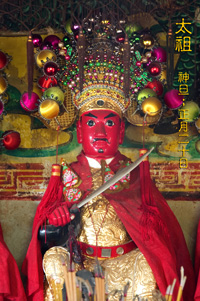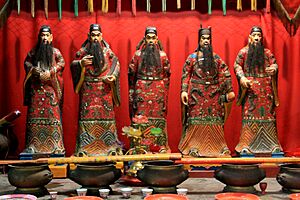Chinese folk religion facts for kids
Chinese folk religion (also called zhōng-guó mín-jiān xìn-yǎng in Chinese) is a set of beliefs and practices followed by many people in China and by Chinese communities around the world. It's sometimes hard to tell where this religion begins and other beliefs end. This is because it includes many different ideas. It has parts of ancestor worship, respect for local spirits, and traditions from Eastern religions like Taoism, Confucianism, and Buddhism. It also includes ideas like superstition, geomancy (which is about how land features affect luck), and Feng shui (arranging things for good energy).
There isn't one main book of stories or a group of priests for this religion. Instead, rituals are often done by the father of a family. Since the 1950s, Chinese folk religion is also called Shenism (Shén-jiào in Chinese). Here, "Shen" means a spirit or a god.
Contents
Understanding Chinese Folk Religion
Chinese folk religion is one of the biggest religious traditions in the world. About 454 million people, or 6.6% of the world's population, follow it. In China, more than 30% of people follow Shenism or Taoism.
How it Relates to Taoism
Sometimes, Chinese folk religion is grouped with Taoism. Over many years, Taoism became an organized religion. It tried to include local customs and beliefs. However, it's more accurate to say that Taoism grew out of Shenism. This is because Shenism existed first. Taoism also developed from Chinese philosophy.
History and Revival
In the last 200 years, religion in China faced many challenges. There were times when it was strongly stopped, like during the Taiping Rebellion and the Cultural Revolution. But today, Chinese folk religion is becoming very popular again. This is happening in both Mainland China and Taiwan.
The government of Mainland China now officially supports different parts of Shenism. For example, they support the worship of Mazu in Southern China. About 160 million Chinese people are Mazuists. They also support the worship of the Huangdi, Black Dragon worship in Shaanxi, and Caishen (the God of Wealth) worship.
Images for kids
-
Xuanyuan Temple in Huangling, Shaanxi, dedicated to the worship of the Yellow Emperor.
-
The Temple of the City God of Wenao, Magong, Taiwan.
-
Temple of Hebo ("River Lord"), the god of the sacred Yellow River, in Hequ, Xinzhou, Shanxi.
-
A sign reading "This is a place of folk belief. No religious donation or religious activities are allowed." Taken in a Chinese folk temple in Weifang City, Shandong Province
-
Communal ceremony at the Great Temple of Yandi Shennong in Suizhou, Hubei.
-
Eastern Han (25–220 AD) Chinese stone-carved que pillar gates of Dingfang, Zhong County, Chongqing that once belonged to a temple dedicated to the Warring States era general Ba Manzi
-
A shrine dedicated to Zhenwu in Wuqi, Taichung, Taiwan.
-
The "First Great Temple by the Riverside", in Zhangzhou, Fujian.
-
People gather for a worship ceremony at an ancestral shrine in Hong'an, Hubei.
-
Temple of the White Sulde of Genghis Khan in the town of Uxin in Inner Mongolia, in the Mu Us Desert. The worship of Genghis is shared by Chinese and Mongolian folk religion.
-
Temple of Fortune and Longevity, at the Heavenly Lake of Tianshan in Fukang, Changji, Xinjiang. It is an example of Taoist temple which hosts various chapels dedicated to popular gods.
-
Main altar and statue of Doumu inside the Temple of Doumu in Butterworth, Penang, Malaysia.
-
Statue and ceremonial complex of the Yellow and Red Gods, from whom the Han Chinese are said to be the descendants, in Zhengzhou, Henan.
-
Shrine of Bixia at Mount Tai, Shandong.
-
Procession with a traveling image of a god in central Taiwan.
-
Vows to a deity at a Chinese temple in Vietnam.
-
A Taoist rite for ancestor worship at the Xiao ancestral temple of Chaoyang, Shantou, Guangdong.
-
Guan Li, Confucian coming of age ceremony.
-
Gathering at a Temple of the City God of Guangzhou, Guangdong.
-
Temple of the Founding Father of the principal holy see of the Plum Flower folk religious sect in Xingtai, Hebei.
-
Folk temple on the rooftop of a commercial building in the city of Wenzhou.
-
Temple of Mazu in Yokohama, serving the Chinese of Japan.
See also
 In Spanish: Religión tradicional china para niños
In Spanish: Religión tradicional china para niños







































